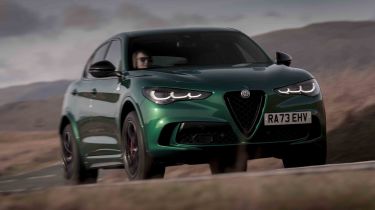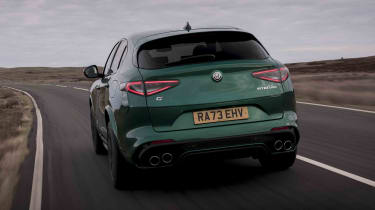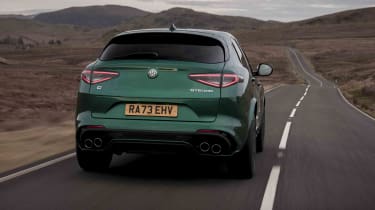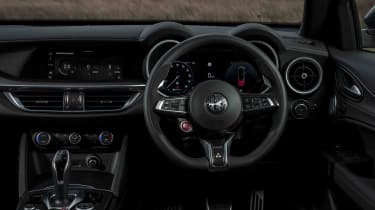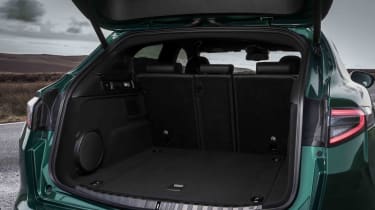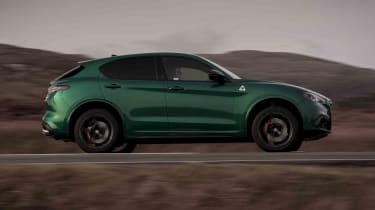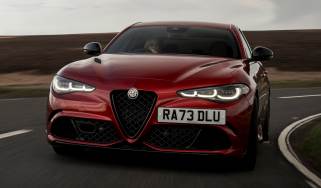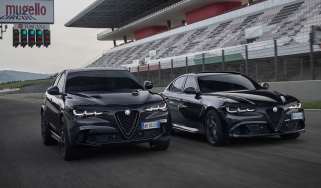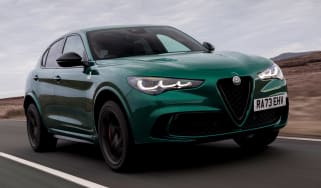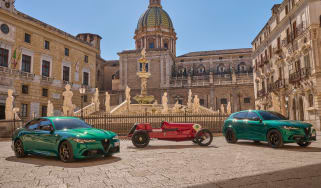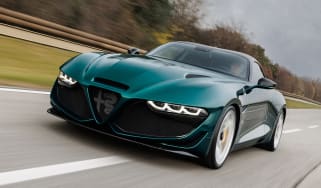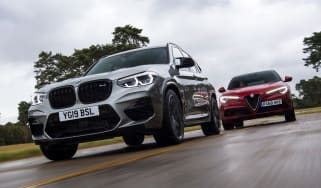Alfa Romeo Stelvio Quadrifoglio review: hot SUV that keeps getting better
The Stelvio Quadrifoglio is one of the best sporty SUVs around, with a raucous engine, sharp handling and handsome styling

Alfa Romeo’s reveal of the Giulia Quadrifoglio super saloon in summer 2015 was followed up a few months later by the Stelvio Quadrifoglio performance SUV. Pitched as a rival to the likes of the Porsche Macan Turbo, Mercedes-AMG GLC 63, Jaguar F-Pace SVR and BMW X3 M Competition, the Stelvio Quadrifoglio stands out thanks to a raucous engine, excellent driving dynamics and typical Italian style.
The Stelvio was the first SUV from Alfa Romeo and even in standard guise it’s a well-mannered mid-sized SUV on the road. The hot Quadrifoglio version, as is the case with the Giulia Quadrioglio, really ramps up the excitement thanks to a twin-turbocharged 2.9-litre V6 with 521bhp. Both cars share the same platform, so the Stelvio drives more like a car than a high-riding SUV.
• Best fast family cars on sale
You don’t take long to realise the engine is the star of the show in the Quadrifoglio. It sounds fantastic, and its power is delivered in spectacular fashion via a quick-witted gearbox and confidence-inspiring yet playful four-wheel drive system - which sends most of its power to the rear. There are genuinely sporty levels of body control, feedback and chassis balance that make the Quadrifoglio one of the very best fast SUVs for those who love driving.
Used - available now

2022 Volvo
XC40
43,072 milesAutomaticPetrol1.5L
Cash £19,900
2018 Mazda
MX-5 RF
65,456 milesManualPetrol2.0L
Cash £12,500
2018 BMW
3 Series
74,919 milesManualDiesel2.0L
Cash £13,000
2026 BMW
3 Series Touring
11,392 milesAutomaticPetrol2.0L
Cash £29,600Of course, there are several indications on the outside that the Stelvio Quadrifoglio is no ordinary SUV. A carbon-fibre bonnet, quad-exhaust tips, bespoke wheels and flared wheel arches all hint at the performance available. Inside, there are plenty of flourishes to define the Quadrifoglio with sports seats, lashings of carbon-fibre trim and an extensive equipment list. It might not feel as solid or premium as German rivals inside, but it’s still a special place to sit.
A further facelift for 2024 thankfully left the handsome exterior design largely alone, with the most notable change being the fancier matrix LED headlights. More involved changes are under the skin, where there were alterations to the suspension and drive modes, and subtle upgrades inside that include a 12.3-inch digital driver instrument cluster, and a revised 8.8-inch central touchscreen.
Engines, performance and drive
The Alfa Romeo Stelvio Quadrifoglio followed on from the Giulia Quadrifoglio saloon in Alfa Romeo’s performance line-up, making use of that car’s 2.9-litre bi-turbo V6 engine and eight-speed auto gearbox. However, in the Stelvio the powertrain is hooked up to Alfa’s Q4 all-wheel drive system to deliver maximum traction.
It’s a rear-biased set-up, and sends 100 per cent of the engine’s power to the rear wheels in normal driving. However, it can also shuffle up to 50 per cent to the front axle when it detects slip – and as a result Alfa claims it can cover 0-62mph in 3.8 seconds and hit 177mph flat out. Those are serious numbers for a car that weighs 1,830kg.
Alfa already has quite a driver-focused SUV in the standard Stelvio, so it’s little surprise that a set of chassis tweaks and installing a stonking engine have improved its dynamic makeup even further. The four-wheel drive powertrain ensures that all 512bhp and 600Nm of torque are fed to the road without any drama, while violent pops and bangs from the exhaust punctuate deep-chested wails from the engine.
After the brutal acceleration, you notice the steering, which is super sharp and accurate; the slightest twitch from your wrist is transmitted directly to the wheels. It instils the Stelvio with a greater sense of agility than its kerbweight would lead you to believe. Combined with the four-wheel drive system, it makes for an incredibly fast and secure performance car.
A wide spread of torque, sharp throttle response and thumping gear changes make it one of the best powertrains in the business. Alfa’s Pro-DNA system brings a host of drive modes, with the lairy Dynamic and Race modes sharpening throttle response, backing off the traction control and opening up the baffles in the quad-tipped exhausts.
Flick the Stelvio through the various drive modes and up to its most aggressive Race setting, and the reins are loosened on the stability control. This allows for a bit more movement at the rear end before the four-wheel drive system gathers it all up and launches you down the road, but even here, it’s incredibly surefooted. There’s torque vectoring on hand to help keep any understeer at bay, and improve agility in the corners.
It’s a beautifully balanced SUV to drive, and a series of suspension tweaks has further broadened the Stelvio’s breadth of abilities. In comfort mode, it’s softer and better able to cope with rubbish road surfaces. In full-on race mode, it's even sharper than before. The car does have its limits, though.
The Stelvio manages its weight 1,830kg weight well, shifting from side to side through high-speed corners extremely well, and giving the far pricier Porsche Cayenne Turbo a serious run for its money. You are always aware of the mass it’s hauling around because it leans a little more through corners than the Giulia Quadrofoglio – although that’s to be expected, given that the Stelvio is taller. Still, at 1,830kg, the aluminium-bodied Stelvio Quadrifoglio is over 200kg leaner than a BMW X3 M Competition, with the Jaguar F-Pace SVR and Mercedes-AMG GLC 63 sitting at 2,070kg and 1,945kg respectively. The brakes could do with a little more bite, but they still provide plenty of stopping power when needed.
MPG, CO2 and Running Costs
Like all high-performance premium cars, the Alfa Romeo Stelvio Quadrifoglio will be a pricey car to run. Official fuel economy figures of 23.9mpg are actually pretty respectable for a car of this size and performance, thanks in part to the engine’s ability to imperceptibly shut down a bank of its cylinders to reduce fuel consumption when cruising at steady speeds of up to around 80mph.
All other expenses will be high by conventional standards. Given the 267g/km CO2 emissions rating, the Stelvio Quadrifoglio sits in the highest first year road tax band, while company car buyers will face the highest-possible 37 per cent Benefit in Kind rate. The Quadrifoglio’s high asking price means it’ll incur a surcharge first five years of ownership because it costs more the £40,000.
The Alfa Romeo Stelvio Quadrifoglio sits in insurance group 50 so premiums will not be cheap. For comparison, the Mercedes GLC 63 S sits in group 47, the BMW X3 M in group 46, and the Jaguar F-Pace SVR is in group 48.
Our experts predict that the Stelvio Quadrifoglio will hold on to around 45 to 46 per cent of its value come trade-in time after three years and 36,000 miles, which is similar to the Jaguar F-Pace SVR. The Mercedes-AMG GLC 63 fares much worse, only holding on to between 37 to 40 per cent over the same period.
Interior, design and technology
The Stelvio Quadrifoglio shares much with its performance saloon cousin, the Giulia Quadrifoglio. The two cars have the same platform and engine, though the Stelvio utilises Alfa Romeo’s Q4 four-wheel drive system.
The similarities continue inside the cabin, where the Stelvio shares much of its design and parts with its saloon counterpart. There are several neat touches to remind you that you are in something special compared with the average Stelvio, though. The Alcantara and carbon fibre steering wheel, red decorative stitching and excellent carbon-backed Sparco bucket seats (which are a rather expensive £3250 option) set the tone without being over-the-top.
Our only reservation about the cabin is that some of the switchgear doesn’t feel or operate with the slickness you’d expect in a premium SUV. That said, the beautiful aluminium gear shift paddles behind the wheel put the plastic offerings in rivals to shame. Overall, the quality is good, no quite as impressive as that found in a Mercedes or BMW but a big step forward over older Alfa Romeo cars.
Like the standard Stelvio, the Quadrifoglio has an 8.8-inch infotainment system that incorporates sat-nav, DAB radio, Apple CarPlay and Android Auto. It’s a big screen that has been incorporated nicely into the top of the dash, and it has been improved upon by adding touch controls to compliment the existing centre-console-mounted rotary controller. Having a physical interface helps make the system easier to control on the move than rivals with only a touchscreen-based system, and a simplification of the menus also aids this ease of use. Another improvement is that the 14-speaker Harman Kardon audio upgrade is now standard on the Quadrifoglio. A wireless phone charging pad is also standard.
Practicality, comfort and boot space
The go-faster Stelvio doesn’t really lose out to its standard counterpart when it comes to practicality. There’s loads of space up front, the cabin boasts plenty of storage for family life and there’s a good-sized boot.
Crucially for a sporty car, the driving position is good too – it’s possible to get really low in the car yet still benefit from the added height of an SUV with a good view out. You don’t get the traditional upright position you’d associate with an SUV either, which is a good thing for those looking a sportier driving experience.
The Alfa Romeo Stelvio Quadrifoglio is longer than most of its rivals, including the Mercedes-AMG GLC 63 and BMW X3M Competition. The Jaguar F-Pace SVR is bigger in every direction, though. The Quadrifoglio measures 4,702mm in length and is 2,163mm wide, including its mirrors.
Much like the standard Stelvio, the rear seats in the Quadrifoglio are spacious enough for adults, although kneeroom suffers slightly if you opt for the Sparco carbon-backed seats. The sloping roof robs a little headroom, but only those over six feet tall will notice. There are two ISOFIX points supplied on the outer positions of the rear bench.
The Stelvio has 525 litres of boot space – 55 more than you’ll find in the back of the Mercedes-AMG GLC 63 but 25 litres less than the BMW X3 M Competition, and considerably smaller than that in the larger F-Pace SVR. In practice, the Stelvio still proves to be practical enough, with a well-shaped square load area and a low load lip.
The rear seats fold with a 40/20/40 split, while an electric tailgate comes as standard for added practicality.
Reliability and Safety
Alfa Romeo performed very well in our 2023 Driver Power, returning to the top steps of manufacturers table with an impressive fifth-place score out of 32 brands included in the survey. Owners have praised the styling and driving performance, with an onus on road handling and steering.
The Stelvio Quadrifoglio comes as standard with a rear view camera, lane-departure warning and blind-spot detection. Although it was an option originally, adaptive cruise control is now standard.
The Stelvio comes with a three-year, unlimited mileage warranty, matching the level of cover provided by Mercedes and BMW.
Alfa Romeo’s Easy Care servicing plan can be customised to fit your car’s use and spread the cost of maintenance. Servicing is required annually or every 9,000 miles, whichever comes soonest. The Stelvio Quadrifoglio requires a timing belt change every 108,000 miles.
